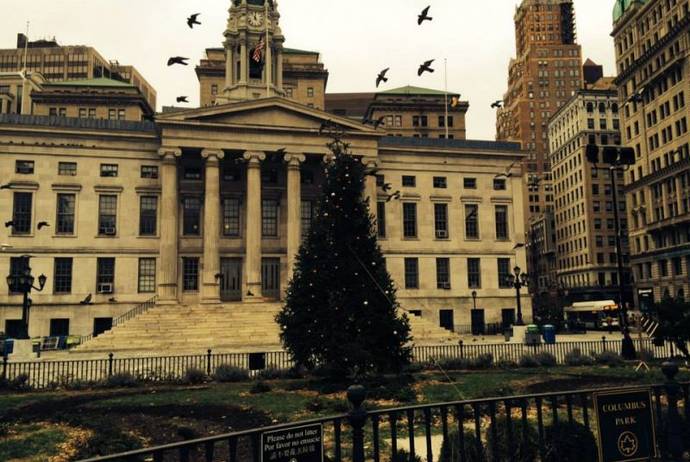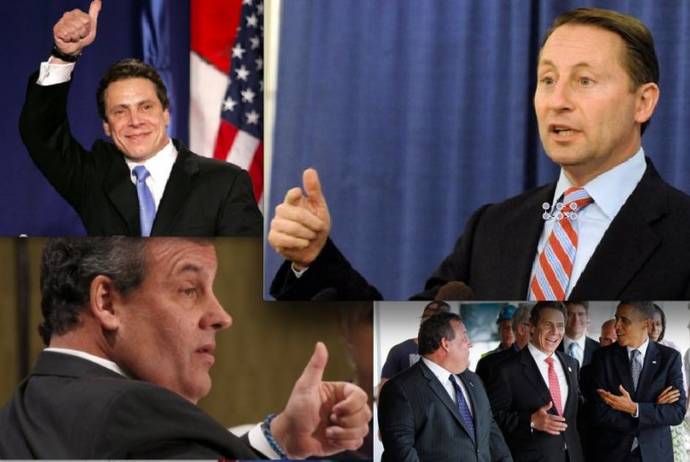Last week I received a last-minute invitation from Brooklyn Borough President Eric L. Adams and "The Committee for Frate Francesco” to attend the grand opening of the historic “Frate Francesco: Friar Francis: Traces, Words, Images “exhibition on Tuesday, December 12th. The impressive four-page e-mail attachment declared it was “a non-transferrable, attendance strictly limited invitation” to which I promptly replied, explaining to my wife that I had to go it alone. However, when I got to Brooklyn Borough Hall early, as I usually am, I discovered that I was inexplicably “not on the list.” Having a lot of prior experience not being a V.I.P., I was not the least bit surprised; but also grateful that I was able to convince a somewhat befuddled staff member that “there must have been a mistake (which wasn’t mine).”
Actually I’ve know the last two Brooklyn “Beeps" (BPs), Howard Golden and Marty Markowitz, pretty well and being accidentally left off an "invitees only" list was old hat for me. Other than letting me in without an invite, the security arrangements were unusually high tech. I had been given the once over with a beeping wand by a very friendly cop even before I got to the “sign in” table, and saw more police and security staff than ever before. Thanks to the wanding, I found some lost change and a few hearing aid batteries. After being admitted I was given a blue wristband that gave me entry to the guarded exhibit. I explained to the wristbander that the color blue (azzurro) was the Italian national color.
Almost immediately after the formal program, I was greeted by the new, and First African American, Beep, Eric L. Adams. As a major part of his job is being multicultural I reminded him that the last time I spoke to him was at the St. Patrick’s Day brunch of the Friendly Sons of St. Patrick. On that day, he, Marty Markowitz, and I were honorarily Irish. During this very Brooklyn reception I met some old, and made some new friends. One of my newest friends is, Jocelyn A. Cooper, the daughter of Andrew W. Cooper. He was a journalist and founder of the City Sun, an Afro-American-oriented newspaper that he used to relentlessly campaign for racial justice. In the 1960s Cooper filed a lawsuit against the Federal government challenging the racially biased Congressional District lines in Brooklyn. This led to the creation of new districts and the election of Shirley Chisolm, the first Black female, to the U.S. Congress. Later, while grazing through the exquisitely presented Umbrian regional delicacies, I found my old friend Cav. Joseph Bova, Democratic District Leader, 49AD. This includes the diverse communities of Bensonhurst, Dyker Heights and Sunset Park. He re-introduced me to Joseph Rizzo, whom I knew when he was a student at Brooklyn College. Joseph provided the Italian to English and English to Italian translations for both the crowd and the many dignitaries during the formal program.
The Frate Francesco exhibition had its U.S. debut at the United Nations, and it was the first time outside of Italy. To paraphrase the late Brooklyn College President, Robert L. Hess “If you want to go far, all you have to do is come to Brooklyn.” While sampling some tasty farro I bumped into a Swedish tourism writer with whom I shared opinions on immigrants in Gothenburg and Stockholm, the Wallander television crime series, and The Girl with the Dragon Tattoo film. On another table, Umbrian wines were being Poured by a “Mediterranean-Looking,” young man. “Are you Italian?” I asked in Italian (Lei e Italiano?) and English. “No. I’m Croatian” he said. “Hvala”(thanks), I replied. A decade after the 1995 Dayton Peace Agreement I participated in some reconciliation workshops in Croatia (Dubrovnik) and Bosnia/Herzogovina (Konjic). NATO (IFOR) “peace keeping” forces were still there. He said he was born after the war in Banja Luka. The city was the site of some of the worst ethnic cleansing, concentration camps, and several massacres. With all the gentrification and displacement going on in Brooklyn it’s nice to know it is still a safe haven for some people. After filling my wine glass, a few times, I met a Polish travel agent with whom I used my limited (mowie troche po Polsku) Polish. I told her how much I loved my visits to Poland and especially my brief stint as a visiting professor at the Jagiellonian University in Krakow. As we continued our conversation she brought me over and introduced me to her foreign tourist agent friends. Two were Italian and the other a Chinese woman (nie hao ma?) who claimed descent from the Chinese Imperial family. They talked excitedly about how Brooklyn had become a favored global tourist destination and how good it was for their business. “Brooklyn is the new Paris,” I said half-jokingly.
Before I left I climbed the grand Borough Hall staircase to see the carefully planned exhibition of some of the oldest and most precious books, letters, and manuscripts relating to Saint Francis of Assisi and the order he founded. The illuminated manuscripts and correspondence were displayed inside glass cases placed upon wooden desks that simulated those used by the monks who carefully inscribed the documents. Mounted panels told the story of Saint Francis and the production of the numerous 12th and 13th-century documents, papal bulls and manuscripts. When I entered several guides were taking people around and explaining the works to adults, as well as a few well-behaved children who accompanied them. The scene, minus the blackened fingers and tongues of the monks, vaguely reminded me of the movie The Name of Rose based on Umberto Ecco’s novel.
After all the great (free) food and drinks and conviality, I have to say that for me at least the highlight of the evening was the reading during the opening ceremony by my fellow Brooklynite John Torturro of the “Prayer of Saint Francis.”
Lord, make me an instrument of Your peace;
Where there is hatred, let me sow love;
Where there is injury, pardon;
Where there is discord, harmony;
Where there is error, truth;
Where there is doubt, faith;
Where there is despair, hope;
Where there is darkness, light;
And where there is sadness, joy.
O Divine Master, Grant that I may not so much seek
To be consoled as to console;
To be understood as to understand;
To be loved as to love.
For it is in giving that we receive;
It is in pardoning that we are pardoned;
And it is in dying that we are born to eternal life.
By the way, did I mention that my Confirmation name was Francis?







































